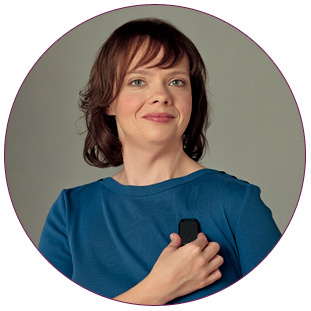|
Simple in-office dose adjustment
Dose adjustment to the pulse generator parameters can easily be made in-office. The typical stimulation cycle is 30 seconds ON followed by 5 minutes OFF.1 Psychiatrists may adjust stimulation with handheld computer and telemetric wand during in-office visits. The dose settings impact how long the battery will last. For example, the battery may last for 3 years at a higher setting, compared with 8 years at a lower setting.2*

*For the full range of settings in relationship to battery life, see the Physician's Manual.
Managing side effects
Most side effects are mild to moderate, only occur during stimulation, and typically decrease over time. If a patient does experience any bothersome side effects, altering parameters such as output current, pulse width, and signal frequency can minimize such effects while maximizing therapeutic benefits.
Dose settings
The VNS Therapy Depression Physician's Manual recommends a waiting period of at least 2 weeks after implant procedure prior to initial dose setting. Then, increase output current in increments of 0.25 mA, or as tolerated.
Frequent office visits (every 2 to 4 weeks) are suggested for the first several months to monitor patient tolerability and adjust device parameters. Increasing output current in increments of 0.25 mA allows the physician to achieve the optimal tolerated dose for each patient. Some patients will accommodate to stimulation levels over time and could therefore allow further increases (in 0.25-mA steps) in output current, if needed.2 Once a patient responds to VNS Therapy, no further changes are necessary. To access an easy to use form to help track your patients' dose adjustment settings, please click here. This Patient Management Form can be placed in your patient's chart and used during each office visit.
Individualization of treatment
Patients should be started on stimulation at a low output current setting (0.25 mA), and the current should be increased gradually to allow accommodation to the stimulation. The table below lists the stimulation parameters reported at 12 months of VNS Therapy.3

The magnet output current should be set to 0 mA.

Using the VNS Therapy magnet
The VNS Therapy magnet is a small handheld magnet that is placed over the pulse generator to stop the stimulation. This can help patients temporarily manage side effects if desired. For example, if they experience voice changes when speaking in public or singing, the patients should hold or place the magnet over the pulse generator during the activity. When they remove the magnet from the pulse generator, VNS Therapy will immediately start again.1
Inform patients that the magnet should always be kept at least 10 inches away from credit cards, televisions, computers, computer discs, microwave ovens, or other magnets. The magnet can break if it hits a hard surface.1 If your patients use the magnet often, they should let you know. The dose may need readjustment.
Hear from a physician
"After about two weeks of recovery or healing, then the device is activated through a wand and a small computer system and the dose that is given to the patient is individualized, or customized. The dose is sought that has minimal side effects but also has therapeutic effect for that individual. The dose adjustments are required typically over the first several weeks or even the first couple of months of VNS Therapy, and after that the device is checked from time to time to be sure that is working properly and further dose adjustments can be made if needed.
If the patient is having troublesome side effects, the patient is given the VNS Therapy magnet which they can place over the device which will stop stimulation. So for example, the patient may be wanting to sing in a choir, or choir rehearsal, they might place the magnet over the device during those rehearsal times and performance times, and yet have the device continue to provide therapy on other occasions when they remove the magnet."
—Dr. A. John Rush, Vice Chair, Department of Clinical Sciences Professor, Department of Psychiatry University of Texas Southwestern Medical Center at Dallas
Listen to this quote
1. Cyberonics, Inc. Epilepsy Patient's Manual. Houston, Tex: 2004.
2. Cyberonics, Inc. Physician's Manual. VNS TherapyTM Pulse Model 102 Generator and VNS TherapyTM Pulse Duo Model 102R Generator. Houston, Tex. 2003.
3. Physician's Manual. VNS TherapyTM Pulse Model 102 Generator and VNS TherapyTM Pulse Duo Model Generator. Houston, Tex: Cyberonics, Inc; 2006.
|